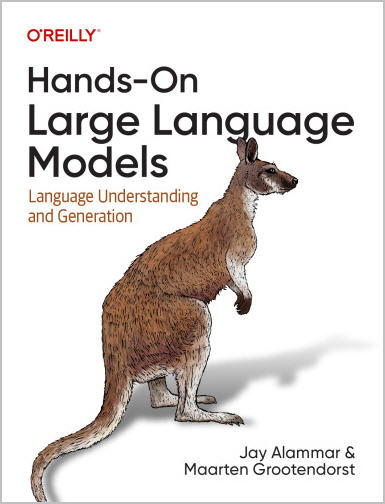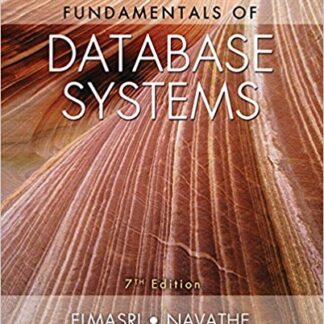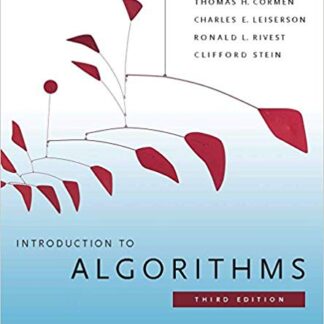Description
Hands-On Large Language Models: Language Understanding and Generation by Jay Alammar, ISBN-13: 978-1098150969
[PDF eBook eTextbook] – Available Instantly
- Publisher: O’Reilly Media; 1st edition (October 15, 2024)
- Language: English
- 425 pages
- ISBN-10: 1098150961
- ISBN-13: 978-1098150969
AI has acquired startling new language capabilities in just the past few years. Driven by rapid advances in deep learning, language AI systems are able to write and understand text better than ever before. This trend is enabling new features, products, and entire industries. Through this book’s visually educational nature, readers will learn practical tools and concepts they need to use these capabilities today.
You’ll understand how to use pretrained large language models for use cases like copywriting and summarization; create semantic search systems that go beyond keyword matching; and use existing libraries and pretrained models for text classification, search, and clusterings.
This book also helps you:
- Understand the architecture of Transformer language models that excel at text generation and representation
- Build advanced LLM pipelines to cluster text documents and explore the topics they cover
- Build semantic search engines that go beyond keyword search, using methods like dense retrieval and rerankers
- Explore how generative models can be used, from prompt engineering all the way to retrieval-augmented generation
- Gain a deeper understanding of how to train LLMs and optimize them for specific applications using generative model fine-tuning, contrastive fine-tuning, and in-context learning
Table of Contents:
Preface
An Intuition-First Philosophy
Prerequisites
Book Structure
Part I: Understanding Language Models
Part II: Using Pretrained Language Models
Part III: Training and Fine-Tuning Language Models
Hardware and Software Requirements
API Keys
Conventions Used in This Book
Using Code Examples
O’Reilly Online Learning
How to Contact Us
Acknowledgments
I. Understanding Language Models
1. An Introduction to Large Language Models
What Is Language AI?
A Recent History of Language AI
Representing Language as a Bag-of-Words
Better Representations with Dense Vector Embeddings
Types of Embeddings
Encoding and Decoding Context with Attention
Attention Is All You Need
Representation Models: Encoder-Only Models
Generative Models: Decoder-Only Models
The Year of Generative AI
The Moving Definition of a “Large Language Model”
The Training Paradigm of Large Language Models
Large Language Model Applications: What Makes Them So Useful?
Responsible LLM Development and Usage
Limited Resources Are All You Need
Interfacing with Large Language Models
Proprietary, Private Models
Open Models
Open Source Frameworks
Generating Your First Text
Summary
2. Tokens and Embeddings
LLM Tokenization
How Tokenizers Prepare the Inputs to the Language Model
Downloading and Running an LLM
How Does the Tokenizer Break Down Text?
Word Versus Subword Versus Character Versus Byte Tokens
Comparing Trained LLM Tokenizers
Tokenizer Properties
Token Embeddings
A Language Model Holds Embeddings for the Vocabulary of Its Tokenizer
Creating Contextualized Word Embeddings with Language Models
Text Embeddings (for Sentences and Whole Documents)
Word Embeddings Beyond LLMs
Using pretrained Word Embeddings
The Word2vec Algorithm and Contrastive Training
Embeddings for Recommendation Systems
Recommending Songs by Embeddings
Training a Song Embedding Model
Summary
3. Looking Inside Large Language Models
An Overview of Transformer Models
The Inputs and Outputs of a Trained Transformer LLM
The Components of the Forward Pass
Choosing a Single Token from the Probability Distribution (Sampling/Decoding)
Parallel Token Processing and Context Size
Speeding Up Generation by Caching Keys and Values
Inside the Transformer Block
Recent Improvements to the Transformer Architecture
More Efficient Attention
The Transformer Block
Positional Embeddings (RoPE)
Other Architectural Experiments and Improvements
Summary
II. Using Pretrained Language Models
4. Text Classification
The Sentiment of Movie Reviews
Text Classification with Representation Models
Model Selection
Using a Task-Specific Model
Classification Tasks That Leverage Embeddings
Supervised Classification
What If We Do Not Have Labeled Data?
Text Classification with Generative Models
Using the Text-to-Text Transfer Transformer
ChatGPT for Classification
Summary
5. Text Clustering and Topic Modeling
ArXiv’s Articles: Computation and Language
A Common Pipeline for Text Clustering
Embedding Documents
Reducing the Dimensionality of Embeddings
Cluster the Reduced Embeddings
Inspecting the Clusters
From Text Clustering to Topic Modeling
BERTopic: A Modular Topic Modeling Framework
Adding a Special Lego Block
The Text Generation Lego Block
Summary
6. Prompt Engineering
Using Text Generation Models
Choosing a Text Generation Model
Loading a Text Generation Model
Controlling Model Output
Intro to Prompt Engineering
The Basic Ingredients of a Prompt
Instruction-Based Prompting
Advanced Prompt Engineering
The Potential Complexity of a Prompt
In-Context Learning: Providing Examples
Chain Prompting: Breaking up the Problem
Reasoning with Generative Models
Chain-of-Thought: Think Before Answering
Self-Consistency: Sampling Outputs
Tree-of-Thought: Exploring Intermediate Steps
Output Verification
Providing Examples
Grammar: Constrained Sampling
Summary
7. Advanced Text Generation Techniques and Tools
Model I/O: Loading Quantized Models with LangChain
Chains: Extending the Capabilities of LLMs
A Single Link in the Chain: Prompt Template
A Chain with Multiple Prompts
Memory: Helping LLMs to Remember Conversations
Conversation Buffer
Windowed Conversation Buffer
Conversation Summary
Agents: Creating a System of LLMs
The Driving Power Behind Agents: Step-by-step Reasoning
ReAct in LangChain
Summary
8. Semantic Search and Retrieval-Augmented Generation
Overview of Semantic Search and RAG
Semantic Search with Language Models
Dense Retrieval
Reranking
Retrieval Evaluation Metrics
Retrieval-Augmented Generation (RAG)
From Search to RAG
Example: Grounded Generation with an LLM API
Example: RAG with Local Models
Advanced RAG Techniques
RAG Evaluation
Summary
9. Multimodal Large Language Models
Transformers for Vision
Multimodal Embedding Models
CLIP: Connecting Text and Images
How Can CLIP Generate Multimodal Embeddings?
OpenCLIP
Making Text Generation Models Multimodal
BLIP-2: Bridging the Modality Gap
Preprocessing Multimodal Inputs
Use Case 1: Image Captioning
Use Case 2: Multimodal Chat-Based Prompting
Summary
III. Training and Fine-Tuning Language Models
10. Creating Text Embedding Models
Embedding Models
What Is Contrastive Learning?
SBERT
Creating an Embedding Model
Generating Contrastive Examples
Train Model
In-Depth Evaluation
Loss Functions
Fine-Tuning an Embedding Model
Supervised
Augmented SBERT
Unsupervised Learning
Transformer-Based Sequential Denoising Auto-Encoder
Using TSDAE for Domain Adaptation
Summary
11. Fine-Tuning Representation Models for Classification
Supervised Classification
Fine-Tuning a Pretrained BERT Model
Freezing Layers
Few-Shot Classification
SetFit: Efficient Fine-Tuning with Few Training Examples
Fine-Tuning for Few-Shot Classification
Continued Pretraining with Masked Language Modeling
Named-Entity Recognition
Preparing Data for Named-Entity Recognition
Fine-Tuning for Named-Entity Recognition
Summary
12. Fine-Tuning Generation Models
The Three LLM Training Steps: Pretraining, Supervised Fine-Tuning, and Preference Tuning
Supervised Fine-Tuning (SFT)
Full Fine-Tuning
Parameter-Efficient Fine-Tuning (PEFT)
Instruction Tuning with QLoRA
Templating Instruction Data
Model Quantization
LoRA Configuration
Training Configuration
Training
Merge Weights
Evaluating Generative Models
Word-Level Metrics
Benchmarks
Leaderboards
Automated Evaluation
Human Evaluation
Preference-Tuning / Alignment / RLHF
Automating Preference Evaluation Using Reward Models
The Inputs and Outputs of a Reward Model
Training a Reward Model
Training No Reward Model
Preference Tuning with DPO
Templating Alignment Data
Model Quantization
Training Configuration
Training
Summary
Afterword
Index
About the Authors
Jay Alammar is Director and Engineering Fellow at Cohere (pioneering provider of large language models as an API). In this role, he advises and educates enterprises and the developer community on using language models for practical use cases). Through his popular AI/ML blog, Jay has helped millions of researchers and engineers visually understand machine learning tools and concepts from the basic (ending up in the documentation of packages like NumPy and pandas) to the cutting-edge (Transformers, BERT, GPT-3, Stable Diffusion). Jay is also a co-creator of popular machine learning and natural language processing courses on Deeplearning.ai and Udacity.
Maarten Grootendorst is a Senior Clinical Data Scientist at IKNL (Netherlands Comprehensive Cancer Organization). He holds master’s degrees in organizational psychology, clinical psychology, and data science which he leverages to communicate complex Machine Learning concepts to a wide audience. With his popular blogs, he has reached millions of readers by explaining the fundamentals of Artificial Intelligence–often from a psychological point of view. He is the author and maintainer of several open-source packages that rely on the strength of Large Language Models, such as BERTopic, PolyFuzz, and KeyBERT. His packages are downloaded millions of times and used by data professionals and organizations worldwide.
What makes us different?
• Instant Download
• Always Competitive Pricing
• 100% Privacy
• FREE Sample Available
• 24-7 LIVE Customer Support




